Case Study: Occupational Therapy Interventions for CMC Osteoarthritis
VerifiedAdded on 2022/09/12
|6
|1601
|12
Case Study
AI Summary
This case study focuses on Martha Washington, a 78-year-old art teacher diagnosed with carpometacarpal (CMC) osteoarthritis, experiencing pain and stiffness in her thumbs, limiting her daily activities. The solution proposes occupational therapy interventions to address her difficulty in pinching and grasping, as well as limitations in strength and endurance. The interventions include the use of physical agent modalities (PAM) like hot pack therapy to reduce pain and promote healing, alongside biomechanical devices such as a custom-made neoprene thumb carpometacarpal orthosis with thermoplastic stabilization. Activity modification strategies are also recommended to protect the CMC joint during function, reducing stress on the thumbs while performing activities of daily living (ADLs) and instrumental activities of daily living (IADLs), such as caring for her handicapped dogs and painting. The overall aim is to improve Martha's functional abilities, reduce pain, and enable her to continue with her daily activities and hobbies.
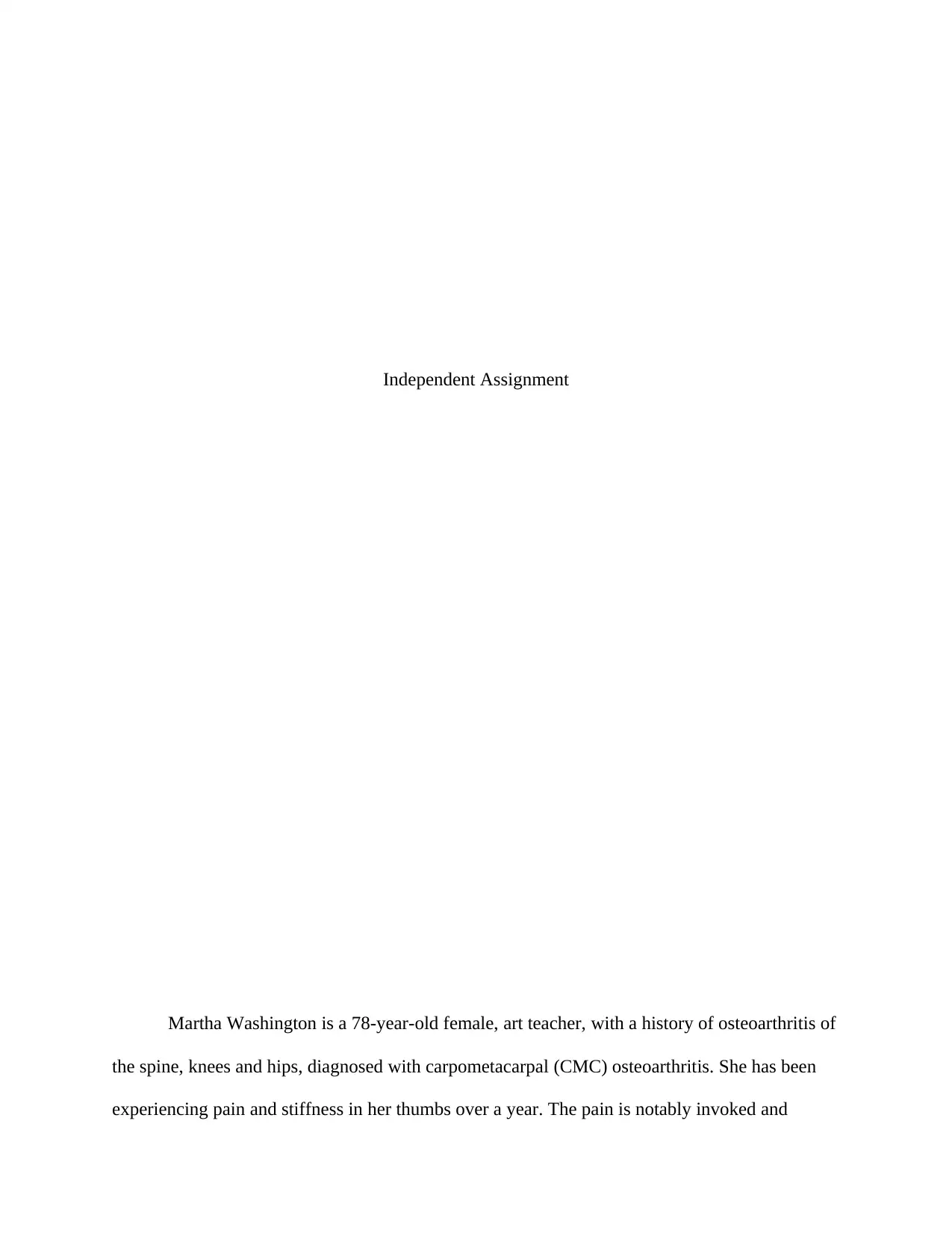
Independent Assignment
Martha Washington is a 78-year-old female, art teacher, with a history of osteoarthritis of
the spine, knees and hips, diagnosed with carpometacarpal (CMC) osteoarthritis. She has been
experiencing pain and stiffness in her thumbs over a year. The pain is notably invoked and
Martha Washington is a 78-year-old female, art teacher, with a history of osteoarthritis of
the spine, knees and hips, diagnosed with carpometacarpal (CMC) osteoarthritis. She has been
experiencing pain and stiffness in her thumbs over a year. The pain is notably invoked and
Paraphrase This Document
Need a fresh take? Get an instant paraphrase of this document with our AI Paraphraser
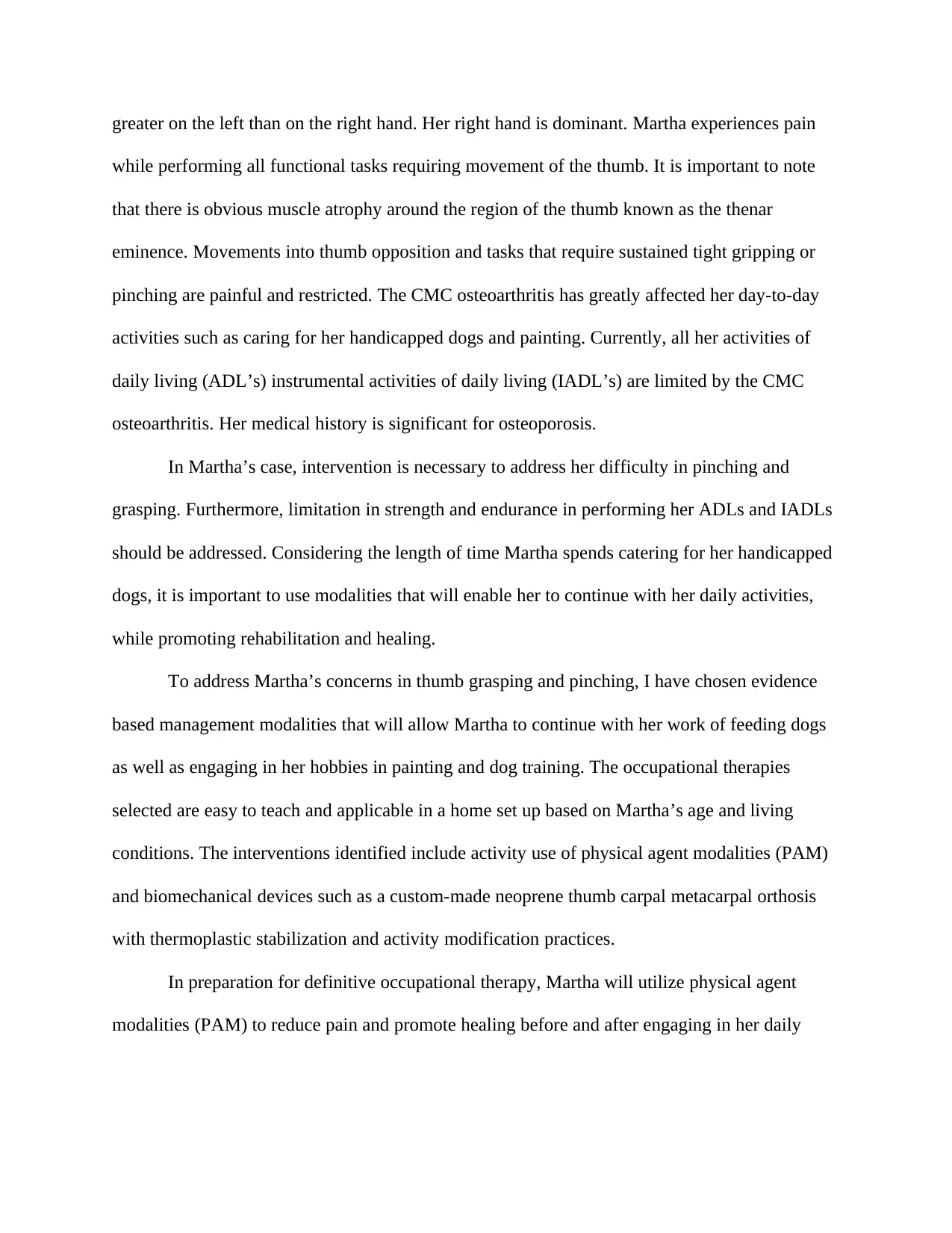
greater on the left than on the right hand. Her right hand is dominant. Martha experiences pain
while performing all functional tasks requiring movement of the thumb. It is important to note
that there is obvious muscle atrophy around the region of the thumb known as the thenar
eminence. Movements into thumb opposition and tasks that require sustained tight gripping or
pinching are painful and restricted. The CMC osteoarthritis has greatly affected her day-to-day
activities such as caring for her handicapped dogs and painting. Currently, all her activities of
daily living (ADL’s) instrumental activities of daily living (IADL’s) are limited by the CMC
osteoarthritis. Her medical history is significant for osteoporosis.
In Martha’s case, intervention is necessary to address her difficulty in pinching and
grasping. Furthermore, limitation in strength and endurance in performing her ADLs and IADLs
should be addressed. Considering the length of time Martha spends catering for her handicapped
dogs, it is important to use modalities that will enable her to continue with her daily activities,
while promoting rehabilitation and healing.
To address Martha’s concerns in thumb grasping and pinching, I have chosen evidence
based management modalities that will allow Martha to continue with her work of feeding dogs
as well as engaging in her hobbies in painting and dog training. The occupational therapies
selected are easy to teach and applicable in a home set up based on Martha’s age and living
conditions. The interventions identified include activity use of physical agent modalities (PAM)
and biomechanical devices such as a custom-made neoprene thumb carpal metacarpal orthosis
with thermoplastic stabilization and activity modification practices.
In preparation for definitive occupational therapy, Martha will utilize physical agent
modalities (PAM) to reduce pain and promote healing before and after engaging in her daily
while performing all functional tasks requiring movement of the thumb. It is important to note
that there is obvious muscle atrophy around the region of the thumb known as the thenar
eminence. Movements into thumb opposition and tasks that require sustained tight gripping or
pinching are painful and restricted. The CMC osteoarthritis has greatly affected her day-to-day
activities such as caring for her handicapped dogs and painting. Currently, all her activities of
daily living (ADL’s) instrumental activities of daily living (IADL’s) are limited by the CMC
osteoarthritis. Her medical history is significant for osteoporosis.
In Martha’s case, intervention is necessary to address her difficulty in pinching and
grasping. Furthermore, limitation in strength and endurance in performing her ADLs and IADLs
should be addressed. Considering the length of time Martha spends catering for her handicapped
dogs, it is important to use modalities that will enable her to continue with her daily activities,
while promoting rehabilitation and healing.
To address Martha’s concerns in thumb grasping and pinching, I have chosen evidence
based management modalities that will allow Martha to continue with her work of feeding dogs
as well as engaging in her hobbies in painting and dog training. The occupational therapies
selected are easy to teach and applicable in a home set up based on Martha’s age and living
conditions. The interventions identified include activity use of physical agent modalities (PAM)
and biomechanical devices such as a custom-made neoprene thumb carpal metacarpal orthosis
with thermoplastic stabilization and activity modification practices.
In preparation for definitive occupational therapy, Martha will utilize physical agent
modalities (PAM) to reduce pain and promote healing before and after engaging in her daily
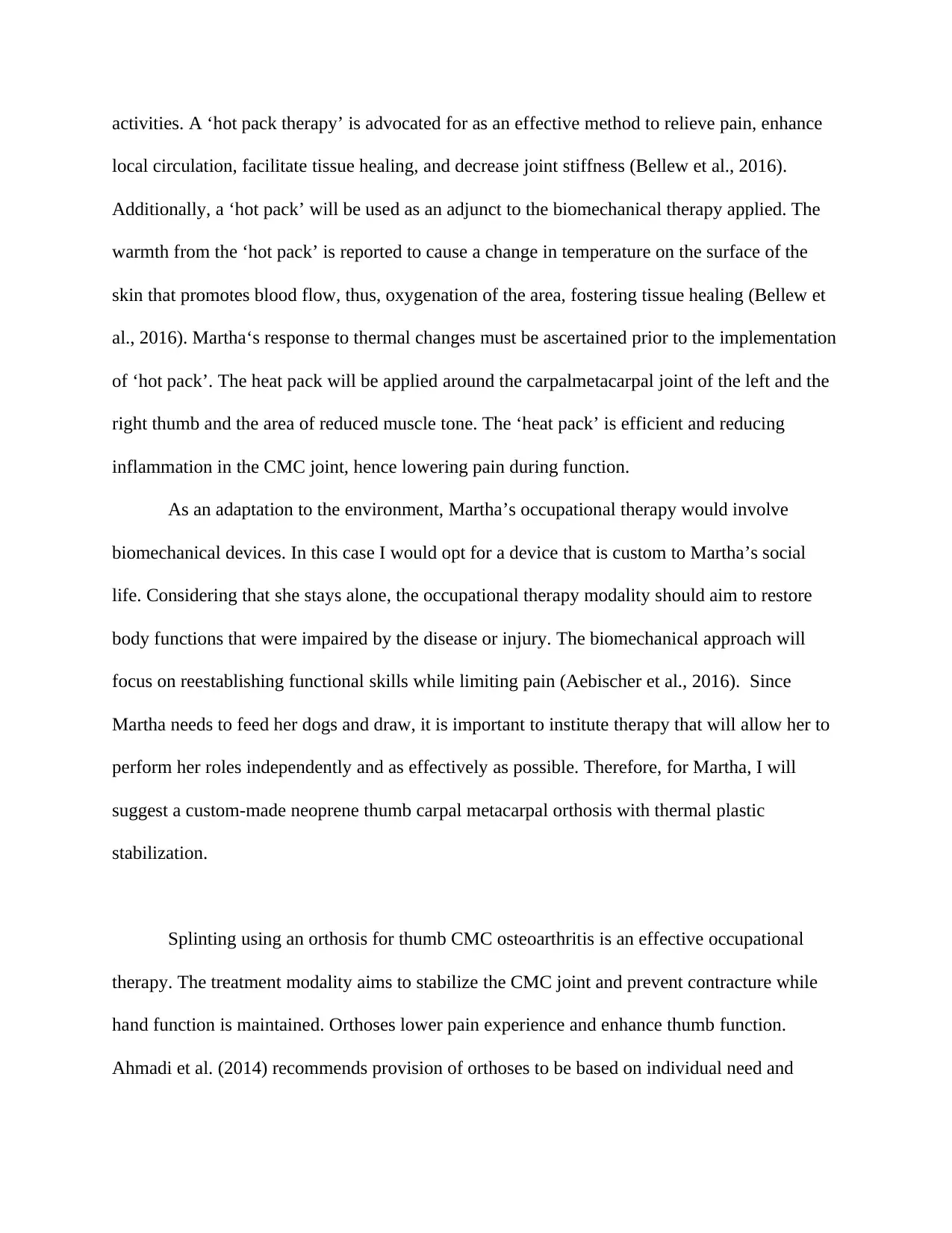
activities. A ‘hot pack therapy’ is advocated for as an effective method to relieve pain, enhance
local circulation, facilitate tissue healing, and decrease joint stiffness (Bellew et al., 2016).
Additionally, a ‘hot pack’ will be used as an adjunct to the biomechanical therapy applied. The
warmth from the ‘hot pack’ is reported to cause a change in temperature on the surface of the
skin that promotes blood flow, thus, oxygenation of the area, fostering tissue healing (Bellew et
al., 2016). Martha‘s response to thermal changes must be ascertained prior to the implementation
of ‘hot pack’. The heat pack will be applied around the carpalmetacarpal joint of the left and the
right thumb and the area of reduced muscle tone. The ‘heat pack’ is efficient and reducing
inflammation in the CMC joint, hence lowering pain during function.
As an adaptation to the environment, Martha’s occupational therapy would involve
biomechanical devices. In this case I would opt for a device that is custom to Martha’s social
life. Considering that she stays alone, the occupational therapy modality should aim to restore
body functions that were impaired by the disease or injury. The biomechanical approach will
focus on reestablishing functional skills while limiting pain (Aebischer et al., 2016). Since
Martha needs to feed her dogs and draw, it is important to institute therapy that will allow her to
perform her roles independently and as effectively as possible. Therefore, for Martha, I will
suggest a custom-made neoprene thumb carpal metacarpal orthosis with thermal plastic
stabilization.
Splinting using an orthosis for thumb CMC osteoarthritis is an effective occupational
therapy. The treatment modality aims to stabilize the CMC joint and prevent contracture while
hand function is maintained. Orthoses lower pain experience and enhance thumb function.
Ahmadi et al. (2014) recommends provision of orthoses to be based on individual need and
local circulation, facilitate tissue healing, and decrease joint stiffness (Bellew et al., 2016).
Additionally, a ‘hot pack’ will be used as an adjunct to the biomechanical therapy applied. The
warmth from the ‘hot pack’ is reported to cause a change in temperature on the surface of the
skin that promotes blood flow, thus, oxygenation of the area, fostering tissue healing (Bellew et
al., 2016). Martha‘s response to thermal changes must be ascertained prior to the implementation
of ‘hot pack’. The heat pack will be applied around the carpalmetacarpal joint of the left and the
right thumb and the area of reduced muscle tone. The ‘heat pack’ is efficient and reducing
inflammation in the CMC joint, hence lowering pain during function.
As an adaptation to the environment, Martha’s occupational therapy would involve
biomechanical devices. In this case I would opt for a device that is custom to Martha’s social
life. Considering that she stays alone, the occupational therapy modality should aim to restore
body functions that were impaired by the disease or injury. The biomechanical approach will
focus on reestablishing functional skills while limiting pain (Aebischer et al., 2016). Since
Martha needs to feed her dogs and draw, it is important to institute therapy that will allow her to
perform her roles independently and as effectively as possible. Therefore, for Martha, I will
suggest a custom-made neoprene thumb carpal metacarpal orthosis with thermal plastic
stabilization.
Splinting using an orthosis for thumb CMC osteoarthritis is an effective occupational
therapy. The treatment modality aims to stabilize the CMC joint and prevent contracture while
hand function is maintained. Orthoses lower pain experience and enhance thumb function.
Ahmadi et al. (2014) recommends provision of orthoses to be based on individual need and
⊘ This is a preview!⊘
Do you want full access?
Subscribe today to unlock all pages.

Trusted by 1+ million students worldwide
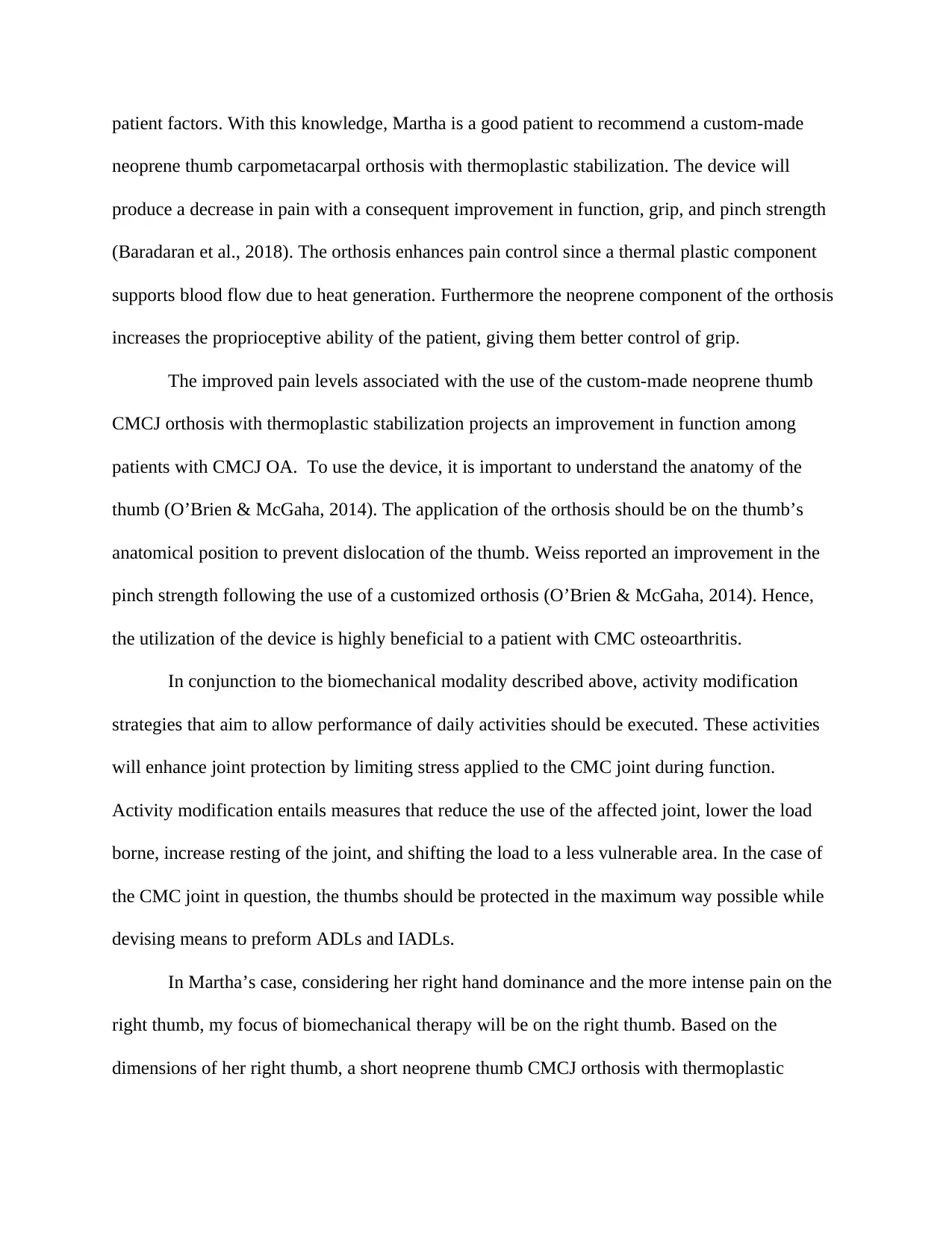
patient factors. With this knowledge, Martha is a good patient to recommend a custom-made
neoprene thumb carpometacarpal orthosis with thermoplastic stabilization. The device will
produce a decrease in pain with a consequent improvement in function, grip, and pinch strength
(Baradaran et al., 2018). The orthosis enhances pain control since a thermal plastic component
supports blood flow due to heat generation. Furthermore the neoprene component of the orthosis
increases the proprioceptive ability of the patient, giving them better control of grip.
The improved pain levels associated with the use of the custom-made neoprene thumb
CMCJ orthosis with thermoplastic stabilization projects an improvement in function among
patients with CMCJ OA. To use the device, it is important to understand the anatomy of the
thumb (O’Brien & McGaha, 2014). The application of the orthosis should be on the thumb’s
anatomical position to prevent dislocation of the thumb. Weiss reported an improvement in the
pinch strength following the use of a customized orthosis (O’Brien & McGaha, 2014). Hence,
the utilization of the device is highly beneficial to a patient with CMC osteoarthritis.
In conjunction to the biomechanical modality described above, activity modification
strategies that aim to allow performance of daily activities should be executed. These activities
will enhance joint protection by limiting stress applied to the CMC joint during function.
Activity modification entails measures that reduce the use of the affected joint, lower the load
borne, increase resting of the joint, and shifting the load to a less vulnerable area. In the case of
the CMC joint in question, the thumbs should be protected in the maximum way possible while
devising means to preform ADLs and IADLs.
In Martha’s case, considering her right hand dominance and the more intense pain on the
right thumb, my focus of biomechanical therapy will be on the right thumb. Based on the
dimensions of her right thumb, a short neoprene thumb CMCJ orthosis with thermoplastic
neoprene thumb carpometacarpal orthosis with thermoplastic stabilization. The device will
produce a decrease in pain with a consequent improvement in function, grip, and pinch strength
(Baradaran et al., 2018). The orthosis enhances pain control since a thermal plastic component
supports blood flow due to heat generation. Furthermore the neoprene component of the orthosis
increases the proprioceptive ability of the patient, giving them better control of grip.
The improved pain levels associated with the use of the custom-made neoprene thumb
CMCJ orthosis with thermoplastic stabilization projects an improvement in function among
patients with CMCJ OA. To use the device, it is important to understand the anatomy of the
thumb (O’Brien & McGaha, 2014). The application of the orthosis should be on the thumb’s
anatomical position to prevent dislocation of the thumb. Weiss reported an improvement in the
pinch strength following the use of a customized orthosis (O’Brien & McGaha, 2014). Hence,
the utilization of the device is highly beneficial to a patient with CMC osteoarthritis.
In conjunction to the biomechanical modality described above, activity modification
strategies that aim to allow performance of daily activities should be executed. These activities
will enhance joint protection by limiting stress applied to the CMC joint during function.
Activity modification entails measures that reduce the use of the affected joint, lower the load
borne, increase resting of the joint, and shifting the load to a less vulnerable area. In the case of
the CMC joint in question, the thumbs should be protected in the maximum way possible while
devising means to preform ADLs and IADLs.
In Martha’s case, considering her right hand dominance and the more intense pain on the
right thumb, my focus of biomechanical therapy will be on the right thumb. Based on the
dimensions of her right thumb, a short neoprene thumb CMCJ orthosis with thermoplastic
Paraphrase This Document
Need a fresh take? Get an instant paraphrase of this document with our AI Paraphraser
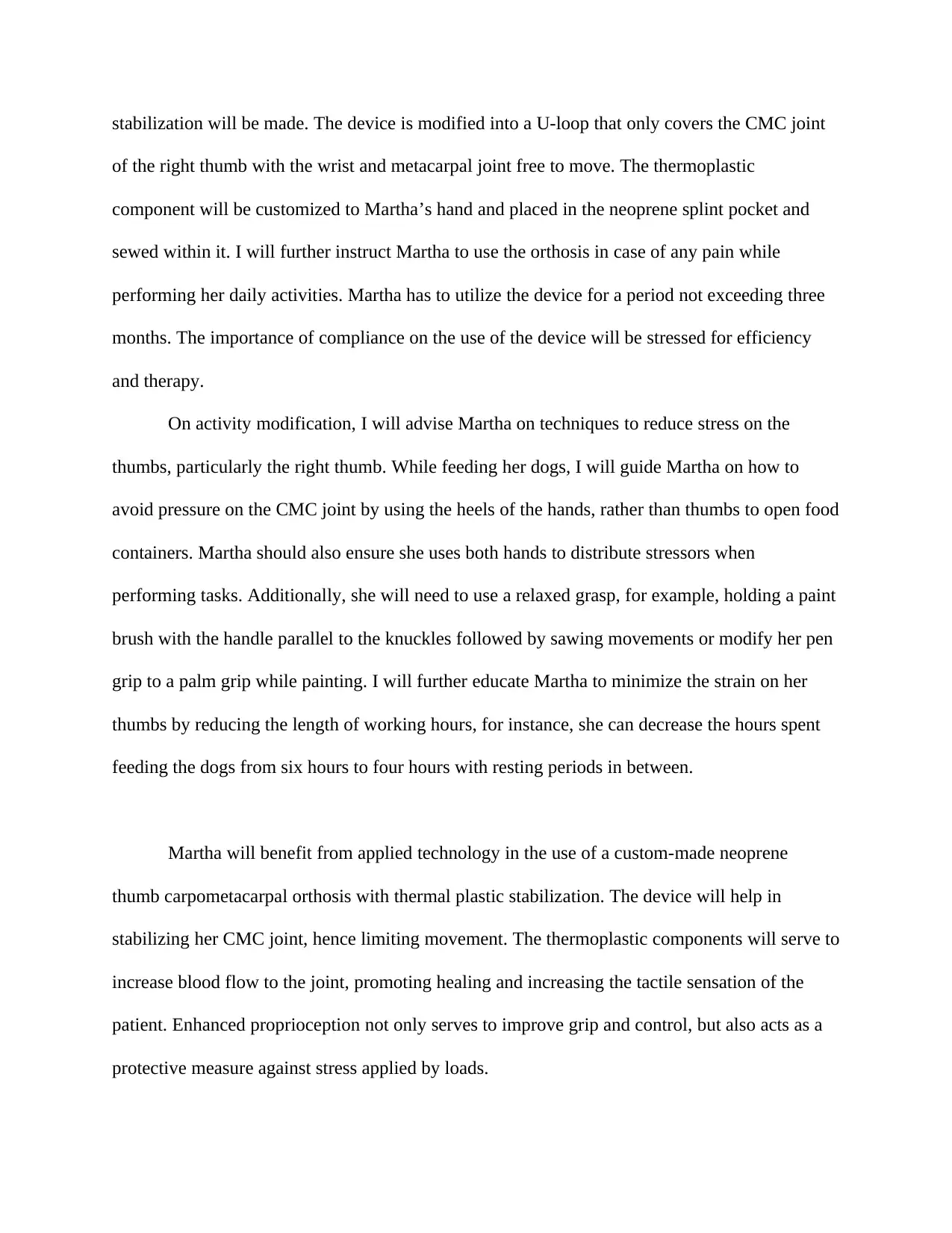
stabilization will be made. The device is modified into a U-loop that only covers the CMC joint
of the right thumb with the wrist and metacarpal joint free to move. The thermoplastic
component will be customized to Martha’s hand and placed in the neoprene splint pocket and
sewed within it. I will further instruct Martha to use the orthosis in case of any pain while
performing her daily activities. Martha has to utilize the device for a period not exceeding three
months. The importance of compliance on the use of the device will be stressed for efficiency
and therapy.
On activity modification, I will advise Martha on techniques to reduce stress on the
thumbs, particularly the right thumb. While feeding her dogs, I will guide Martha on how to
avoid pressure on the CMC joint by using the heels of the hands, rather than thumbs to open food
containers. Martha should also ensure she uses both hands to distribute stressors when
performing tasks. Additionally, she will need to use a relaxed grasp, for example, holding a paint
brush with the handle parallel to the knuckles followed by sawing movements or modify her pen
grip to a palm grip while painting. I will further educate Martha to minimize the strain on her
thumbs by reducing the length of working hours, for instance, she can decrease the hours spent
feeding the dogs from six hours to four hours with resting periods in between.
Martha will benefit from applied technology in the use of a custom-made neoprene
thumb carpometacarpal orthosis with thermal plastic stabilization. The device will help in
stabilizing her CMC joint, hence limiting movement. The thermoplastic components will serve to
increase blood flow to the joint, promoting healing and increasing the tactile sensation of the
patient. Enhanced proprioception not only serves to improve grip and control, but also acts as a
protective measure against stress applied by loads.
of the right thumb with the wrist and metacarpal joint free to move. The thermoplastic
component will be customized to Martha’s hand and placed in the neoprene splint pocket and
sewed within it. I will further instruct Martha to use the orthosis in case of any pain while
performing her daily activities. Martha has to utilize the device for a period not exceeding three
months. The importance of compliance on the use of the device will be stressed for efficiency
and therapy.
On activity modification, I will advise Martha on techniques to reduce stress on the
thumbs, particularly the right thumb. While feeding her dogs, I will guide Martha on how to
avoid pressure on the CMC joint by using the heels of the hands, rather than thumbs to open food
containers. Martha should also ensure she uses both hands to distribute stressors when
performing tasks. Additionally, she will need to use a relaxed grasp, for example, holding a paint
brush with the handle parallel to the knuckles followed by sawing movements or modify her pen
grip to a palm grip while painting. I will further educate Martha to minimize the strain on her
thumbs by reducing the length of working hours, for instance, she can decrease the hours spent
feeding the dogs from six hours to four hours with resting periods in between.
Martha will benefit from applied technology in the use of a custom-made neoprene
thumb carpometacarpal orthosis with thermal plastic stabilization. The device will help in
stabilizing her CMC joint, hence limiting movement. The thermoplastic components will serve to
increase blood flow to the joint, promoting healing and increasing the tactile sensation of the
patient. Enhanced proprioception not only serves to improve grip and control, but also acts as a
protective measure against stress applied by loads.
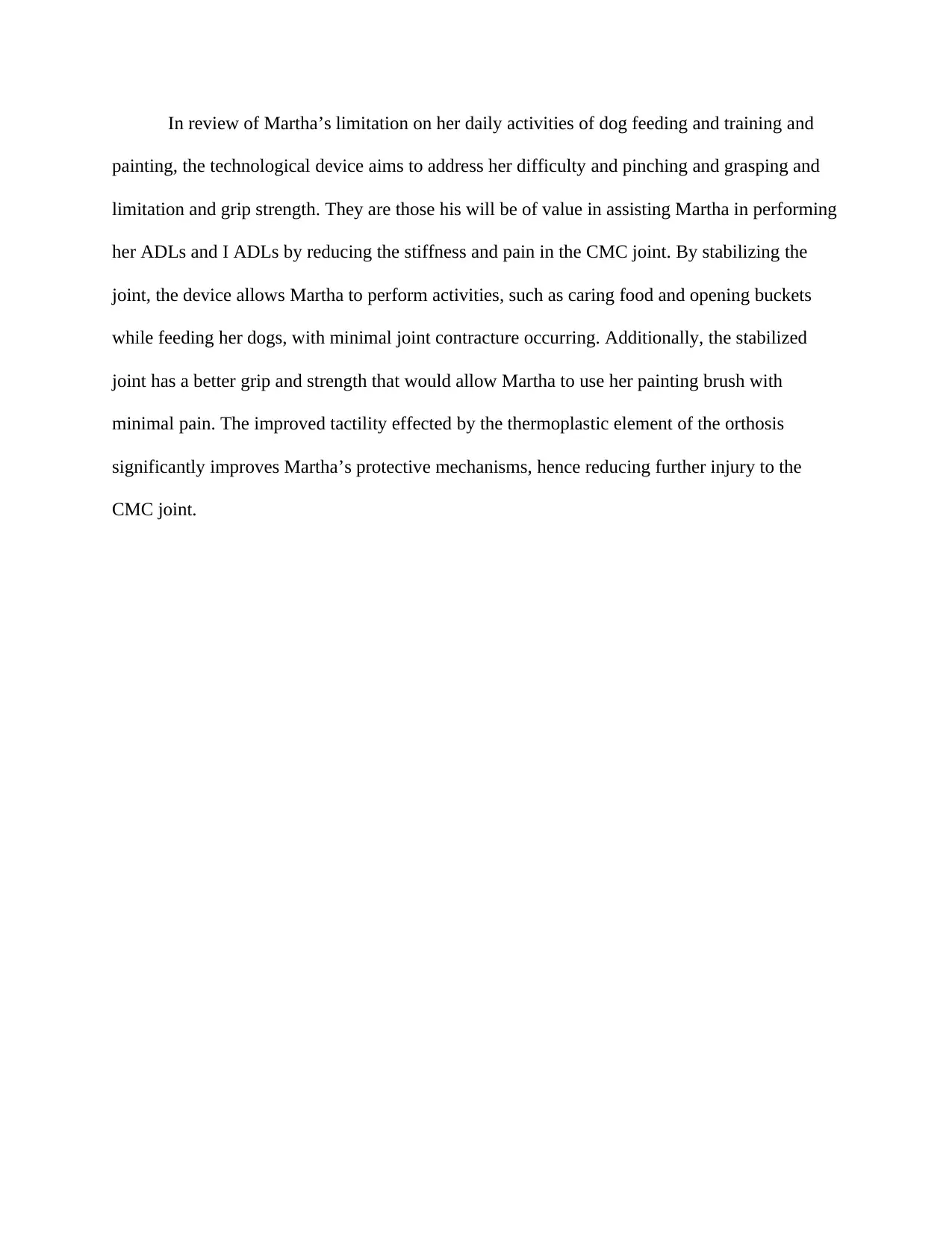
In review of Martha’s limitation on her daily activities of dog feeding and training and
painting, the technological device aims to address her difficulty and pinching and grasping and
limitation and grip strength. They are those his will be of value in assisting Martha in performing
her ADLs and I ADLs by reducing the stiffness and pain in the CMC joint. By stabilizing the
joint, the device allows Martha to perform activities, such as caring food and opening buckets
while feeding her dogs, with minimal joint contracture occurring. Additionally, the stabilized
joint has a better grip and strength that would allow Martha to use her painting brush with
minimal pain. The improved tactility effected by the thermoplastic element of the orthosis
significantly improves Martha’s protective mechanisms, hence reducing further injury to the
CMC joint.
painting, the technological device aims to address her difficulty and pinching and grasping and
limitation and grip strength. They are those his will be of value in assisting Martha in performing
her ADLs and I ADLs by reducing the stiffness and pain in the CMC joint. By stabilizing the
joint, the device allows Martha to perform activities, such as caring food and opening buckets
while feeding her dogs, with minimal joint contracture occurring. Additionally, the stabilized
joint has a better grip and strength that would allow Martha to use her painting brush with
minimal pain. The improved tactility effected by the thermoplastic element of the orthosis
significantly improves Martha’s protective mechanisms, hence reducing further injury to the
CMC joint.
⊘ This is a preview!⊘
Do you want full access?
Subscribe today to unlock all pages.

Trusted by 1+ million students worldwide
1 out of 6
Your All-in-One AI-Powered Toolkit for Academic Success.
+13062052269
info@desklib.com
Available 24*7 on WhatsApp / Email
![[object Object]](/_next/static/media/star-bottom.7253800d.svg)
Unlock your academic potential
Copyright © 2020–2025 A2Z Services. All Rights Reserved. Developed and managed by ZUCOL.

